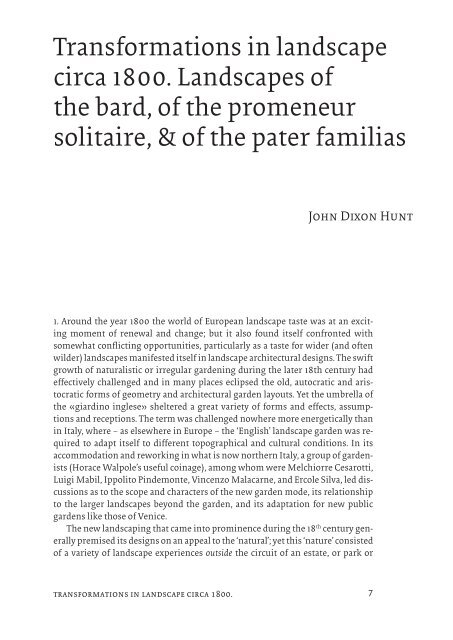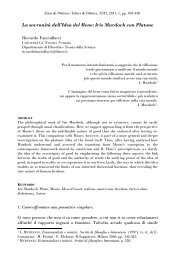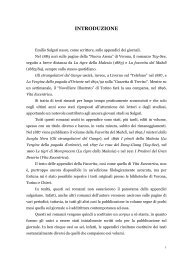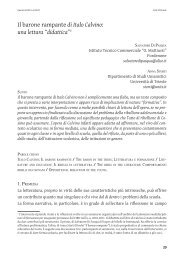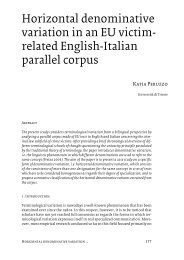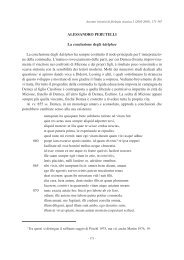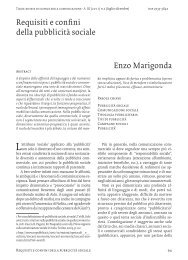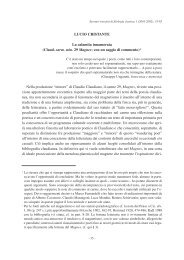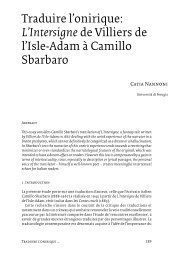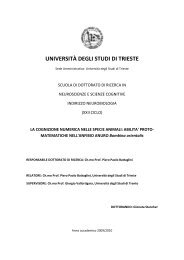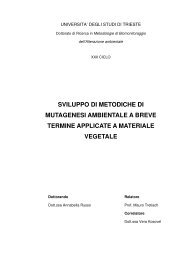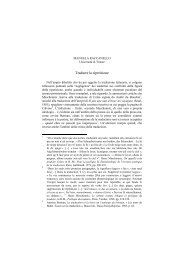- Page 1: Melchiorre Cesarotti e le trasforma
- Page 4: Melchiorre Cesarotti e le trasforma
- Page 10 and 11: that the druidic bards of this prim
- Page 12 and 13: ers turned for their subjects. 10 T
- Page 14 and 15: That the meditations may verge upon
- Page 16 and 17: cesses of the so-called English sty
- Page 18 and 19: neither to rely on the poetry of En
- Page 20 and 21: 3 Humphrey Repton, from the Red Boo
- Page 22 and 23: 8 The cliffs in landscape park at H
- Page 24 and 25: 12. The Public Gardens, detail from
- Page 26 and 27: Et défendez au fer d’outrager la
- Page 28 and 29: primo termine è quello positivo).
- Page 30 and 31: trasporto di gioia, facendo una sen
- Page 32 and 33: 4. Nell’usare il termine di «nat
- Page 34 and 35: porteranno lo sforzo, la languidezz
- Page 36 and 37: license answers to the full / Th’
- Page 38 and 39: La «natura» incarnata da Ossian e
- Page 40 and 41: l’efficacia di questa categoria n
- Page 42 and 43: tivi - di evoluzione e perfezioname
- Page 44 and 45: ipresa con ricchezza di motivi da G
- Page 46 and 47: consapevolezza di un nuovo modo d
- Page 48 and 49: si trova a frequentare quegli intel
- Page 50 and 51: Alla base del ‘giardino filosofic
- Page 52 and 53: 1781 gli Idilli di Gessner tradotti
- Page 54 and 55: Certo, quando io veggo un bello cam
- Page 56 and 57: poetica del giardino moderno che pr
- Page 58 and 59:
Un’interpretazione veneta del nuo
- Page 60 and 61:
tagonisti, diversi tra loro per cul
- Page 62 and 63:
La teorizzazione di pari dignità e
- Page 64 and 65:
mento: la Teoria dell’arte de’
- Page 66 and 67:
mirto, a dimostrazione di come tale
- Page 68 and 69:
Nell’analisi del percorso specula
- Page 70 and 71:
pindarico e si abbandonano alla bel
- Page 72 and 73:
cittadine nel suo «romitaggio» 48
- Page 74 and 75:
Il letterato condivide la passione
- Page 76 and 77:
mo. Alle volte, mentre io stava stu
- Page 78 and 79:
Consultando il catasto napoleonico
- Page 80 and 81:
(tradotto in Italia con il titolo L
- Page 82 and 83:
lizzazioni nate dall’Ossian. Scri
- Page 84 and 85:
Satis beatus unicis Sabinis. Te, Ca
- Page 86 and 87:
1. Villa Cesarotti a Selvazzano, pr
- Page 88 and 89:
4.La gran carta del Padovano di G.
- Page 90 and 91:
7. Pianta della villa e del giardin
- Page 92 and 93:
Melchiorre Cesarotti, tra Inghilter
- Page 94 and 95:
giudiziosamente valendosi della sua
- Page 96 and 97:
Poesie di Ossian nel 1763, e poi ri
- Page 98 and 99:
ui ordine troviamo e varietà Diver
- Page 100 and 101:
Anche per Cesarotti esercizio del g
- Page 102 and 103:
cio, foriera di intensa sincerità
- Page 104 and 105:
Si susseguono così endecasillabi c
- Page 106 and 107:
Non si deve dimenticare che il giro
- Page 108 and 109:
Se ne può trarre una conclusione p
- Page 110 and 111:
Le citazioni petrarchesche sono evi
- Page 112 and 113:
Ciò che si può leggere nel Canzon
- Page 114 and 115:
Tale condizione di “torpore”, p
- Page 116 and 117:
2. Le motivazioni da cui prese orig
- Page 118 and 119:
un sol portico». 20 È evidente: i
- Page 120 and 121:
cittadini; per contribuire a quella
- Page 122 and 123:
stumo del padre Lodoli 42 è un rac
- Page 124 and 125:
La forza riformatrice dell’idea p
- Page 126 and 127:
3.D. Cerato, L. Sacchetti, La nuova
- Page 128 and 129:
«isoletta sacra al commercio ed al
- Page 130 and 131:
Un amico in visita al ‘Selvagiano
- Page 132 and 133:
Cesarotti - e soprattutto in merito
- Page 134 and 135:
L’amicizia tra Cesarotti e de Laz
- Page 136 and 137:
stesso dopo quella di Mabil, esiste
- Page 138 and 139:
taria, essendogli stato però prefe
- Page 140 and 141:
Perché, Giovanni, - apostrofa il B
- Page 142 and 143:
«rozzo tempietto agreste», che se
- Page 144 and 145:
di convenienza, le amicizie (o le i
- Page 146 and 147:
Il ruolo di Ercole Silva nella diff
- Page 148 and 149:
In apertura del XIX secolo il Silva
- Page 150 and 151:
e briantei, che in quegli anni prom
- Page 152 and 153:
Lo spunto operativo va invece ricon
- Page 154 and 155:
Consiste questo edificio in una sez
- Page 156 and 157:
dino e documentata nelle varie ediz
- Page 158 and 159:
FoNti bibliograFiChe e. silVa, Trat
- Page 160 and 161:
3.Villa Ghirlanda Silva, Cinisello,
- Page 162 and 163:
7. Regio Parco presso Monza. Porta
- Page 164 and 165:
11. Villa Ghirlanda Noseda Bertani,
- Page 166:
Appendice
- Page 169 and 170:
differente sentire, l’accordo ini
- Page 171 and 172:
I COLLI EUGANEI Se dolce antico ed
- Page 173 and 174:
Dove i remi batteano, appunta il de
- Page 175 and 176:
Raggrinza il volto, o fa men certo
- Page 177 and 178:
Son di fermo saver provida scola; 2
- Page 179 and 180:
Panneggiamenti e padiglioni, e quin
- Page 181 and 182:
uante Vendemmie, donde Samo e Chio
- Page 183 and 184:
Opulenza, avarizia, invidia ed ira
- Page 185 and 186:
Antico nido è questo, e ben mel di
- Page 187 and 188:
ual altro mai lo pareggiò, l’agg
- Page 189 and 190:
generalmente convengono a tutte le
- Page 191 and 192:
torrenti devastatori in siffatte va
- Page 193 and 194:
(c) Cioè per l’acque Termali, e
- Page 195 and 196:
BASSANO Pur vi riveggo, o del natal
- Page 197 and 198:
Ecco l’ospite nido, ecco la terra
- Page 199 and 200:
Locò primiero a ingentilir menzogn
- Page 201 and 202:
Aggrappolarsi aggraticciarsi a un f
- Page 203 and 204:
Dell’Urbinate suo fama rispande.
- Page 205 and 206:
Le rive alternamente... Ahi! che no
- Page 207 and 208:
Immagine d’orror! ual ti dipingi
- Page 209 and 210:
Non curante del poi, dell’oggi ar
- Page 211 and 212:
L’onda beata, e la balsamic’aur
- Page 213 and 214:
(7) La Stamperia del Sig. Co. Giuse
- Page 215 and 216:
Volge romito di Meronte il passo. I
- Page 217:
sulla cultura visiva, sul Modernism


